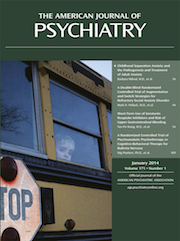The recently published observational study by Zivin et al. (
1) examined the risk of cardiac arrhythmias and mortality among patients taking high-dosage (>40 mg/day), medium-dosage (21–40 mg/day), and low-dosage (≤20 mg/day) citalopram. The authors concluded that high-dosage citalopram was not associated with increased rates of cardiac arrhythmias or overall mortality compared with low-dosage citalopram. Indeed, higher dosages were associated with fewer adverse outcomes; the unadjusted mortality rate for patients taking high dosages was about half that observed with low dosages. On the basis of their findings, they questioned the FDA’s warning to avoid dosages exceeding 40 mg/day. The approach the authors took, however, was unlikely to detect differences in potentially life-threatening arrhythmias, and for reasons explained below, we believe the 60 mg/day citalopram dosage should be avoided.
A randomized, placebo- and active-controlled, double-blind, dose-escalation, crossover study (a “thorough QT study”) has unequivocally demonstrated dose-dependent QT prolongation with citalopram. The 60 mg/day dosage caused greater prolongation (18.5 ms) than lower dosages (20 mg/day, 8.5 ms; 40 mg/day, 12.6 ms) and the standard active control drug known to prolong the QT interval (moxifloxacin, 13.4 ms) (
2). Although the magnitude of QT effect leading to concern is a matter of judgment, QT prolongation above 15 ms can increase the risk of potentially fatal torsade de pointes-type ventricular tachycardia (
3). Under real-world conditions, drug interactions can magnify the effect, as has been demonstrated with citalopram and pimozide (
4). Most important, even if the increase in mortality risk from the 60 mg/day dosage is small, use of that dosage cannot be justified, as it was not more effective than 40 mg/day in phase 3 trials (
5). Therefore, the FDA updated the labeling for citalopram and, in 2011 and 2012, issued drug safety communications advising avoidance of citalopram dosages above 40 mg/day (
2).
Observational studies using large administrative databases have not been successful for identifying drug-induced torsade de pointes (
6). None of eight observational cohort studies conducted to evaluate the cardiac safety of cisapride or terfenadine, which have been removed from the U.S. market because they clearly cause torsade de pointes, showed an increased risk with either drug (
6–
8). Torsade de pointes is rare, even with drugs that unequivocally cause it; the incidence rate is estimated to be in the range of 1 per 12,000 to 120,000 patients (
6). Moreover, a person who develops fatal ventricular tachycardia or ventricular fibrillation following torsade de pointes will only rarely be identified as having torsade. Detected torsade cases are survivable cases lasting long enough without decompensation to allow for an ECG. For such a rare event, case reports, despite being subject to many potential biases, are the principal practical means of signal identification, as was the case for terfenadine and cisapride. An examination of 88 spontaneous torsade cases reported in Sweden found citalopram to be the third most commonly implicated drug-related precipitating factor, listed as the single suspected agent in five cases and as being involved in a total of nine cases (
9).
When torsade de pointes cannot be specifically identified as an outcome (the usual case), less specific outcomes—such as any ventricular arrhythmia or cardiac or overall mortality, as used by Zivin et al.—will include a large number of outcomes unrelated to QT prolongation. This would dilute a signal of QT prolongation-induced torsade or sudden cardiac death, biasing toward a null result. If the excess mortality attributable to torsade among users of high-dosage citalopram is 1 in 12,000 patients, it would have accounted for only 10 of the 2,519 (832 cardiac) deaths recorded in the high-dosage citalopram group in the Zivin et al. study, too small a difference to be detectable.
Since citalopram was approved in 1998, its labeling has recommended a dosage of 20 mg/day in most elderly patients because of increased serum levels and a longer half-life of citalopram in this patient group compared with younger patients (
5). Such dose-related concern may have led to selective prescribing of lower dosages to older and sicker patients (channeling bias). Indeed, Zivin et al. found that “both older patients and patients with higher comorbidity levels received lower dosages of both citalopram and sertraline.” Although the authors attempted to control for differences in comorbidity, they used only a few very general indicators of comorbidity that are unlikely to be sufficient to adequately account for large differences in prognosis (suggested by unadjusted differences in mortality rates) among patients treated with high-dosage citalopram compared with low-dosage citalopram. Although prescribing practice may have mitigated some risk for ventricular arrhythmias, selective prescribing also means that study subgroups were unlikely to be comparable. This is supported by the finding that high-dosage sertraline was also associated with fewer adverse outcomes than low-dosage sertraline.
Clinical trial data, case reports, and studies in animals provide clear evidence for dose-dependent QT prolongation with citalopram. The nearly 20-ms mean effect (18.5 ms) on QT observed at the 60 mg/day dosage represents a significant concern, especially since this dosage was not more effective than 40 mg/day in clinical trials. The observational study by Zivin et al. does not mitigate the concern that led to the FDA’s recommendation to avoid the 60 mg/day dosage (
10).

